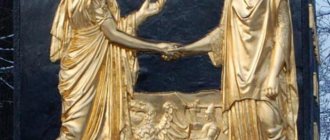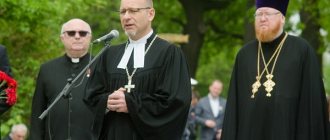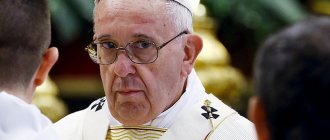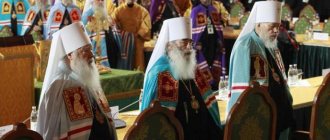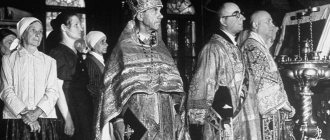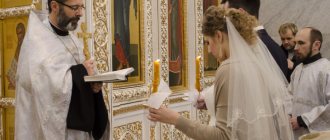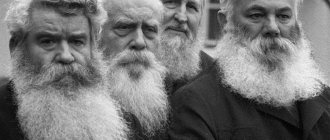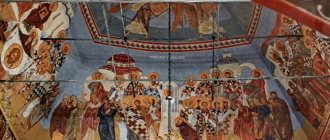Even in our time, the Ferraro-Florence Council of 1438-1445, at which the Union of Florence was adopted, causes fierce disputes both between historians and between Christians of the West and the East.
If for Catholics it, like the Ecumenical Council, is completely legal and the decisions are undeniable, then the Orthodox consider it a colossal mistake committed by the highest hierarchs of the Byzantine Church. The goal of the Empire, besieged by the Turks, to receive full-scale assistance from the West, was not achieved, and the desire of Catholics for the true unity of the Christian Church has since been subject to doubt in the East.
What is the Union of Florence
This is the name given in the works of historians to the agreement concluded in 1439 in Florence between the Eastern (Orthodox) and Western (Roman Catholic) Christian churches and declaring their formal unification.
The Orthodox confession recognized the primacy of Catholicism, led by the Roman Pontiff, the dogmas of purgatory and the procession of the Holy Spirit.
But she still retained the right to some of her own customs:
- Greek-language worship:
- possibility for priests, if they are not monks, to marry:
- communion of ordinary parishioners not only with the Body of Christ - in the form of bread, but also with His Blood - in the form of wine.
Trials of Metropolitan Isidore
Just as the members of the Constantinople delegation, returning from Italy, were met with the indignation of their compatriots, so the envoy of the Russian Orthodox Church, Metropolitan Isidore of Kyiv, who signed the union, received a very cold reception in Moscow. Grand Duke Vasily II, who ruled at that time, was extremely outraged by his apostasy and direct betrayal of the interests of the state.
By his order, the disgraced bishop was taken into custody and imprisoned in the dungeon of the Chudov Monastery, from where, however, he safely fled first to Tver and then to Hungary. There is an opinion among researchers that the success of the escape was facilitated by the Grand Duke himself, who wanted to establish contact with the Hungarian king Vladislav III, who shortly before had proclaimed the equality of the Catholic and Orthodox churches in his country, as well as in Poland under his control.
History of the Ferraro-Florence Cathedral
The XVII Ecumenical Council was convened by Pope Eugene IV as a counterweight and continuation of the Basel Council, which began in 1431. It was unusual in that it was attended by senior clergy from both denominations of Christianity. Its locations were Ferrara (1438-1439), Florence (1439-1442) and Rome (1442-1445).
Historical background
At that time, the weakened Christian world needed unification. Europe has still not recovered from the Crusades, the Byzantine Empire was almost completely captured by the Turks, and Rus' was subjected to Tatar raids.
For almost a century the Turks had occupied a foothold in Europe. Sultan Murad I turned Adrianople into his capital, and the troops of the Orthodox Serbs suffered a crushing defeat on Kosovo.
Under these conditions, the help of Western Christians was simply vital to Byzantium; the emperor understood that only an alliance with Rome could provide him with such help. Pope Eugene IV, who was also very interested in the unification of Christianity, made it a condition for the help of all Catholic Europe to conclude a union between the Eastern and Western churches. For this purpose, it was planned to convene a special Council, at which the best minds of Christianity could resolve the contradictions between the creeds of Constantinople and Rome.
Goals
Those gathered had a clear and precise goal, at first glance: the harmonization of dogmatic nuances between Orthodox and Catholics. Overcoming the contradictions in the Creed was the key to concluding an alliance - a union, with the help of which the Pope, on the one hand, could claim absolute leadership in Christian countries, and the Emperor of the “Second Rome” John VIII from the Palaiologan family, on the other, hoped to preserve the last provinces of his once a great state from the Ottoman conquest. As a result, by agreement of the parties, the Council was recognized as Ecumenical.
Participants of the Council
Many clergy who participated in the Basel Council that preceded it did not appear at the Council, which was the reason for their condemnation. The Pope, who led the Council, and the Byzantine Emperor, who approved it, were its inspirers.
More than seven hundred people came from the Orthodox Church, among them:
- Patriarch Joseph II;
- legates of all Orthodox patriarchs;
- two metropolitans - Isidore of Kiev and All Rus', who was elevated to bishop especially for this event;
- Metropolitan of Moldovala, a state that at that time occupied Moldova, part of Ukraine and Romania;
- bishop and representative of the royal house of Georgia.
Metropolitan Isidore, then bearing the title of Kyiv, arrived accompanied by the Suzdal bishop Abraham and many Russian priests.
Representatives of the Bulgarian and Serbian Orthodox churches did not attend the Council. Also, the monarchs of the West, whom the representatives of Byzantium had been waiting for, did not participate in it.
Unlike the Catholics, there were very few educated theologians in the huge Orthodox delegation. Among them are the legate of the Jerusalem Patriarch Mark of Ephesus and the representative of the Alexandrian throne, Vissarion of Nicea, as well as several scientists who did not bear the priesthood.
These were lay philosophers:
- Georgy Scholarius;
- Georgy Amirutts;
- George of Trebizond;
- elderly Georgy Gemist Plithon.
In the delegation of Rome, headed by Cardinal Cesarini, all members were to one degree or another theologically educated.
Its best minds were considered to be scientists who belonged to the Order of St. Dominica:
- Archbishop of Rhodes, Greek by birth, Andrew Chrysoberg;
- Archbishop of Lombardy John of Montenegro;
- Spanish Bishop John de Torquemada.
Pope Eugene IV himself was not inferior to them in knowledge of church dogma.
Holding a council
The Council of Ferrara-Florence officially began in Ferrara on April 1, 1438, with a solemn meeting under the leadership of the Pope, although working meetings had already been going on for more than two months.
Many questions were raised by the requirements of the protocol, which the Orthodox refused to comply with. For example, they did not kiss the papal shoe, as everyone else did in Catholic Europe. The Patriarch simply kissed the Pope on the cheek as a greeting.
It was also not possible to seat the participants of the Council immediately. The fact is that Catholics count the sides of the temple from the altar, and Orthodox - from the entrance. Therefore, the thrones of the Pope and the Holy Roman Emperor were placed on the right in accordance with the custom of Western Christians, and the Emperor of Byzantium and the Patriarch were placed on the right according to the custom of the East.
Back in the spring, immediately after the opening, the Council interrupted its work at the request of the Emperor of Byzantium, who wanted to wait for the arrival of European monarchs, and its meetings continued only in October. Canonical differences in religions were discussed.
In the winter of 1439 the cathedral moved to Florence. It was officially announced that the move was due to the fact that Italy was engulfed in a plague epidemic. But, according to the research of ancient and modern historians, this reason is not true: the epidemic had already ended by the time of the move. The Pope simply ran out of funds for the maintenance of the Council, and he could replenish his treasury only in Florence, which was loyal to him.
In the capital of Tuscany, the parties continued discussions about the procession of the Holy Spirit, and on June 4, a compromise formulation was signed based on the addition of “filioque” to the Creed, and after the death of the Patriarch of Constantinople on June 10, other central issues were quickly agreed upon - the priority of papal power, the existence of purgatory and etc.
Finally, on July 5, the hierarchs of the Eastern Church, including Isidore and Abraham from Russia, signed a document recognizing the union. The Moldovan Church also approved it. Only Mark of Ephesus officially refused to sign the document due to disagreement with its doctrine, and representatives of the Georgian, Abkhaz and other local churches, who also did not sign anything, simply left the Council without any statements.
In August, the Byzantine delegates also left Florence.
What issues were resolved
Since two Councils were taking place simultaneously, at first the participants in the Ferraro-Florence Council adopted decretals on its canonicity and condemned the cardinals and other priests who remained in Basel and even elected the antipope. Dogmatic disputes began in the summer of 1438 with a discussion about the procession of the Holy Spirit, that is, about the legality of adding the word “filioque” to the Christian Creed adopted at the Council of Nicaea-Constantinople. As a result, the addition of this word by the Western Church was approved and confirmed the procession of the Holy Spirit from both the Father and the Son.
Following this fundamental decision, the Council approved provisions on the right of the Pope to be the Supreme Pontiff of all Christians, as well as on the Eucharist and purgatory. As a result, Pope Eugene IV published the bull “Laetantur caeli”, which approved the unification of Christians of the Eastern and Western Churches. The text of the decision was signed by the Byzantine Emperor John VIII, 116 Catholic and 32 Orthodox delegates.
The document stated that the dogmatic contradictions between the currents of Christianity have been overcome, the concepts of the procession of the Holy Spirit “from the Father and the Son” and “from the Father through the Son” do not contradict each other. The Bishop of Rome, that is, the Pope, is the successor of St. Peter, and therefore has the highest authority in any Christian church. The existence of purgatory was emphasized, and the equivalence of the Eucharistic use of leavened bread and unleavened bread was recognized. Until now, for Catholics this bull has the status of an infallible canon.
Continuing its work after the departure of the Greek delegation, the Council:
- He canceled the decision of the Council of Constance on the subordination of the Pope to the Ecumenical Councils.
- Alliances were concluded with the Armenian and Coptic churches, and already in Rome - with the Maronite Church.
- The problems of the possibility of priests entering into marriage, as well as the acceptability of divorce, were raised, but they decided to postpone them to a later time.
The last meetings of the Council were held in Rome at the end of the summer of 1445.
Newly minted theologians
The Catholic hierarchs considered their main opponents to be representatives of the Byzantine delegation, although they had an extremely superficial understanding of them, believing that they would have to deal with venerable theologians. In reality, most of its members had a very superficial religious education and were not capable of conducting serious discussions.
As evidenced by a number of historical documents of that era, experiencing an extreme shortage of qualified church hierarchs, Patriarch Joseph II, by order of the emperor, was forced, literally on the eve of his departure, to elevate to the rank of bishops some secular intellectuals who had the widest range of knowledge, but at the same time had little understanding of matters of faith . It is for this reason that the envoys of Constantinople could not compete with the Roman theologians.
Results and consequences
History has shown that the Council did not achieve the goals that its participants set for it.
Attitude of European states
Catholics in Western Europe received the news of the conclusion of the union rather indifferently. In any case, historical sources do not indicate any special celebrations that took place in honor of what seemed to be such an important event as the unification of Christians around the world.
Orthodox Christians in Europe, with the exception of Muscovite Rus', reacted more warmly to this event. Metropolitan Isidore, taking advantage of his high spiritual rank in the Orthodox Church and the fact that he was endowed with the rank of cardinal, returning from the Council through the lands of the Polish-Lithuanian Commonwealth in 1440-1441, took a number of actions to introduce a union in Poland and the Grand Duchy of Lithuania. Here, on the western borders of Rus', some Christians, including the nobility, still professed Orthodoxy and responded favorably to Isidore’s appeals. But the rulers of Poland and the Grand Duchy of Lithuania were in no hurry to provide state support for the union.
The reasons for such indifference, if not enmity, were, first of all, the confrontation between two popes: Eugene IV, on whose initiative the agreement was signed, and Felix V, elected by the Basel Council and supported by Poland.
So the Catholic Church itself had enough internal problems, and no one wanted to take on the problems of Eastern Christians - neither the hierarchs nor the secular authorities. In addition, a significant role in the delay in recognition of the union was played by the position of Prince Yuri Lugvenovich, who, having achieved independence from the Grand Duchy of Smolensk for a short period of time in 1440, counting on the support of Rome, introduced it on his lands. Therefore, the attitude towards this union and the decisions of the Council in general was ambiguous.
Russia's attitude
The conclusion of the Union of Florence in Rus' was perceived with hostility. Metropolitan Isidore, trying to prove that it was not in vain that he was one of the luminaries of the Ferrara-Florence Cathedral, began to enforce its decisions at such a pace and on such a scale that he amazed even Prince Vasily and his boyars who had seen everything.
Considering that the Metropolitan put Bishop Jonah of Ryazan in prison in order to force him to sign the Uniate Acts, and a simple Russian monk, who was in the Metropolitan’s retinue, in his report calls the Catholics “heretics” and not “brothers in Christ,” while declaring the Byzantines hierarchs are apostates and bribe-takers, it is easy to imagine the public opinion of Orthodox Rus'.
Upon returning from the Council, Isidore began to “break” Orthodox customs.
Eg:
- the eight-pointed cross familiar to Eastern Christians was replaced with a four-pointed one;
- The prayers indicated that the Pope should be remembered before the Patriarch.
Within a week, Grand Duke Vasily II the Dark and his entourage decided to stop such desecration of Orthodoxy, removed Metropolitan Isidore from office and sent him to the Chudov Monastery.
Having escaped from prison, after numerous adventures typical of a knight errant rather than a Christian bishop, Isidore gradually achieved the highest positions in both churches, but Moscow no longer recognized his rule.
At the end of 1448, the Council of Russian Clergy, against the will of Constantinople, elected Bishop Jonah as the spiritual ruler of all Rus'. This was the first primate elected from among the Russian, and not the Greek, clergy, and one could have expected an appropriate reaction, even anathema, but Constantinople, whose hands were tied, chose to remain silent. Thus, the Moscow Church acquired autocephaly, and, although the attitude towards the union in Constantinople often changed, this no longer affected anything. With the destruction of the Byzantine Empire, the “cradle of Orthodoxy,” Moscow actually acquired the status of the “Third Rome”; over time, the head of the Russian church began to be called the Patriarch, and the Moscow princes - tsars.
Refusal of the union
Almost all the Byzantine bishops who returned home also disavowed their signatures on the documents of the Council on the grounds that they were forced to do so under duress. The most powerful blow to the union was dealt by the position of the very influential priest Mark of Ephesus - the only one who loudly spoke out against it at the Council. He united the Orthodox around himself.
In 1443 in Jerusalem, and in 1450 in Constantinople, councils were held with the participation of the Eastern patriarchs, at which the Uniates were excommunicated. At the Council of Constantinople, Patriarch Gregory Mamma, a supporter of the union, was forced to give way to the orthodox Orthodox Athanasius.
However, the official church, together with the emperor of Byzantium in 1452, reaffirmed its commitment to the Florentine agreements, and on December 2 of the same year, the first service according to their canons was held in the Hagia Sophia. There were only a few months left before the fall of Constantinople.
It is worth noting that Pope Eugene IV did not break his vows and sent an army of crusaders against the Turks. True, in 1448, in the battle of Nicaea, the Christians were defeated, and 5 years later the Turks took the capital of Byzantium.
Replacing the Patriarch
In order to avoid conflict and the bloodshed inevitable in such cases, John VIII made the only reasonable decision in this situation on the need to resign the previous patriarch and elect a new one. However, this good undertaking was drowned in a sea of intrigue. As a result, the head of the Church of Constantinople, and therefore the entire Orthodox world, became Metropolitan Mitrofan, who did not stain himself by signing the shameful union, but was its secret supporter. According to historians, this choice was one of the reasons for the tragedy that took place in 1453, when hordes of the Turkish Sultan Mehmed II appeared under the walls of the Byzantine capital.
Despite opposition from the majority of clergy and ordinary laity, the union adopted at the Ferraro-Florence Council received official status, and on December 12, 1452 it was read out within the walls of Hagia Sophia. The metropolitans present were forced to affix their signatures to the document, but soon most of them backed down, saying that they did this under pressure from the emperor.
The significance of the council's decisions in history
The Union between the Catholic and Orthodox Churches of 1439, an attempt to unite the Christian churches of the East and West, was a complete failure, dividing Christians even more deeply into Orthodox and Catholics. However, in one local area - on the territory of Ukraine and Belarus, then belonging to the Grand Duchy of Lithuania - this agreement determined the development of the Christian church for many years.
For Russia, the main consequence of the union is the acquisition of autocephaly. Guided by the fact that “Tsargrad”, that is, Constantinople, followed the lead of the “Latins”, “schismatics”, “heretics”, Moscow decided to reject the spiritual support of Byzantium, especially since this state soon ceased to exist, and the throne of its Patriarch lost influence. As a result, the Moscow Metropolitan was installed without the blessing of Constantinople, and the Orthodox Church of Rus' was divided into two metropolitanates with centers in Moscow and Kyiv.
If Kyiv remained faithful to the “cradle of Orthodoxy,” even though it was under the heel of the Turks, then Moscow began to publish the works of its theologians year after year, castigating the “Greek defectors” and glorifying the steadfastness and inflexibility in the faith of the Moscow princes.
In the case of the Kyiv Metropolis, everything was more complicated. Until the beginning of the 16th century, the Roman pontiffs took a direct part in its affairs, appointing metropolitans in accordance with the Florentine agreements. In conditions when the Uniate Patriarch of Constantinople lived in Rome, the status of the Kyiv diocese was in limbo.
For several decades, the metropolitans did not recognize the fact that the documents on the basis of which the reconciliation of churches was achieved were no longer valid either in the eyes of Rome or in the eyes of Constantinople, which became Istanbul. And only more than half a century after the Council, which became the beginning of the union, they became convinced that the highest Catholic hierarchs of Poland and the Grand Duchy of Lithuania considered it to have lost all meaning.
Only a century and a half later, the Union of Brest of 1596 revived the spirit and principles of its predecessor, but at a local rather than a church-wide level.
Formation of Uniate churches
The Ferraro-Florence Cathedral entered the history of Catholicism as a very important and significant event. In addition to the union with the Byzantines, who subsequently refused to fulfill their obligations, similar agreements were signed with representatives of many other Orthodox churches, which to this day recognize their legal validity.
It is also important that the Ferrara-Florence Council and the consequences of its decisions served as an impetus for the formation of a number of Uniate Greek Catholic churches, one of which, founded in the Polish-Lithuanian Commonwealth, united many residents of the southwestern regions of Russia. In terms of its status, it is a local Catholic Church, using Greek rituals in its services. In general, for the country, the most important consequence of the signing of the union was the withdrawal of the Russian Orthodox Church from subordination to the Patriarch of Constantinople and the proclamation of its autocephaly (independence).


